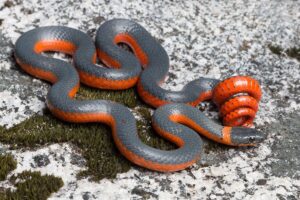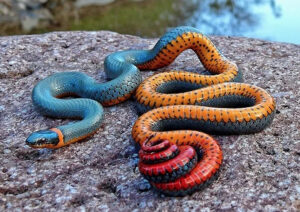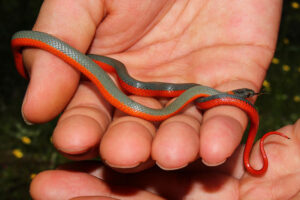Thanks for joining us for another Wildlife Wednesday! You might think you know all the snakes slithering around Northern California, but there’s one you’ve probably never spotted, despite it being surprisingly common. The Ring-necked Snake, Diadophis punctatus, is a small, shy reptile that spends most of its time hidden under logs, rocks, or leaf litter. But if you’re lucky enough to find one, you’ll be treated to one of the most strikingly beautiful little snakes in North America! And it’s venomous! Let’s meet this surprisingly stunning, secretive serpent.
Ring-necked Snakes are petite compared to many of their serpentine cousins in our region. Adults typically only measure between 10 and 15 inches long, although they can get up to two feet. Well, they don’t actually get two feet because, of course, they’re snakes. Snakes have no feet. Sorry, I digress. Back to the snakes…
The back of a Ring-necked Snake is usually a dark slate gray, black, or even olive green. Around its neck is its namesake, a thin ring that can be pale yellow, bright orange, or even red. Its belly is the real showstopper, covered in vibrant colors ranging from buttery yellow to brilliant red. In many individuals, the colors shift gradually along the belly, from yellow towards the head, to orange further down the body, to bright red towards the tail end!



The Ring-necked Snake is widespread, found from southeastern Canada through the eastern portion of the U.S. and into the desert southwest states and Mexico. There are scattered populations throughout the Pacific states, including California. The species is divided into at least 10 recognized subspecies, each with slightly different color patterns and ranges. California is home to four subspecies, two of which you’re likely to see here in the northern part of the state. The Pacific Ring-necked Snake, Diadophis punctatus amabilis, is found along the coast and in the Coast Range from central California north into Washington. In the low foothills of the Sierra Nevada Range, you’ll find the Coral-bellied Ring-necked Snake, Diadophis punctatus pulchellus. They’re both exquisite little snakes, with the Pacific Ring-necked Snake having more distinct spots along its brightly colored belly.
Ring-necked Snakes prefer moist microhabitats where they can easily stay hidden. They are masters of secrecy, tucking themselves under leaf litter, loose bark, and rotting logs. These snakes are also mostly nocturnal, venturing out under the cover of darkness, making them even more challenging to find.
Ring-necked Snakes are technically venomous. But don’t worry! The venom is too mild and the venom yields too small (a mere 0.1 — 0.3 mg) for it to cause any medically significant effects in humans. It’s essentially harmless to people, though it might cause mild localized swelling or irritation, like a mosquito bite. To further set your mind at ease, Ring-necked Snakes are opisthoglyphous, meaning they have rear-positioned fangs that deliver their venom. These fangs are so tiny and positioned so far back in their mouth that they would have difficulty opening their mouths wide enough to effectively bite a human, further limiting their ability to inject venom. The venom contains mild toxins, including certain enzymes designed to break down tissues and immobilize their preferred prey, soft-bodied snacks like slugs, earthworms, salamanders, and the occasional tiny frog.
Despite their secretive habits, Ring-necked Snakes aren’t entirely safe from predators. Birds of prey, especially small owls, such as the Northern Pygmy Owl and Western Screech Owl will eat Ring-necked Snakes. They also fall prey to larger snakes, including California Kingsnakes, which love eating other snakes and lizards. Other predators include skunks, raccoons, and even domestic cats. But the Ring-necked Snake employs some fascinating defenses to protect itself!
When threatened, the Ring-necked Snake strikes a dramatic pose. It curls the tail end of its body into a tight corkscrew spiral, tucks its head under the middle of its body, and flashes the brilliant reds and oranges of its belly! Perhaps when the tail is coiled so tightly, it makes the tail end appear larger and more like a head so, if the predator attacks, just the tail will be bitten, a much less vital part of the body. The snake’s head will be protected in the middle of its body.
Many species of animals use bright warning colors to let predators know that they’re venomous, poisonous, or simply taste bad. Hence, many predators have learned to avoid these warning colors. Even though the Ring-necked Snake isn’t really dangerous, by displaying its vibrant underside, the snake tricks the predator into believing it’s toxic or distasteful. This is a great example of biological mimicry.
If the Ring-necked Snake’s warning colors and defensive pose don’t work, the snake has another trick up its sleeve (or scales). From its cloaca (the snake’s multi-purpose opening used for mating and excreting), it releases a foul-smelling musk, often mixed with feces, to discourage would-be attackers! Yuck! Of course, its best defense is to simply stay hidden in its secret shelters, avoiding detection in the first place.
All of us at Splash encourage you to be curious naturalists and go explore the great outdoors! If you venture out on a quest to find a Ring-necked Snake, remember to check all sides of a rock or log before you reach to turn it over. You don’t want to surprise a basking rattlesnake on the other side! But also remember that, if you turn over a rock or log, you’re lifting the roof off someone’s home! Always place the rock or log back very gently and carefully, exactly as you found it. With patience and luck, you might be rewarded with a glimpse of this secretive creature with the bright little “necklace!” Now you’ll know that you’ve found a Ring-necked Snake, truly one of northern California’s most colorful hidden treasures!